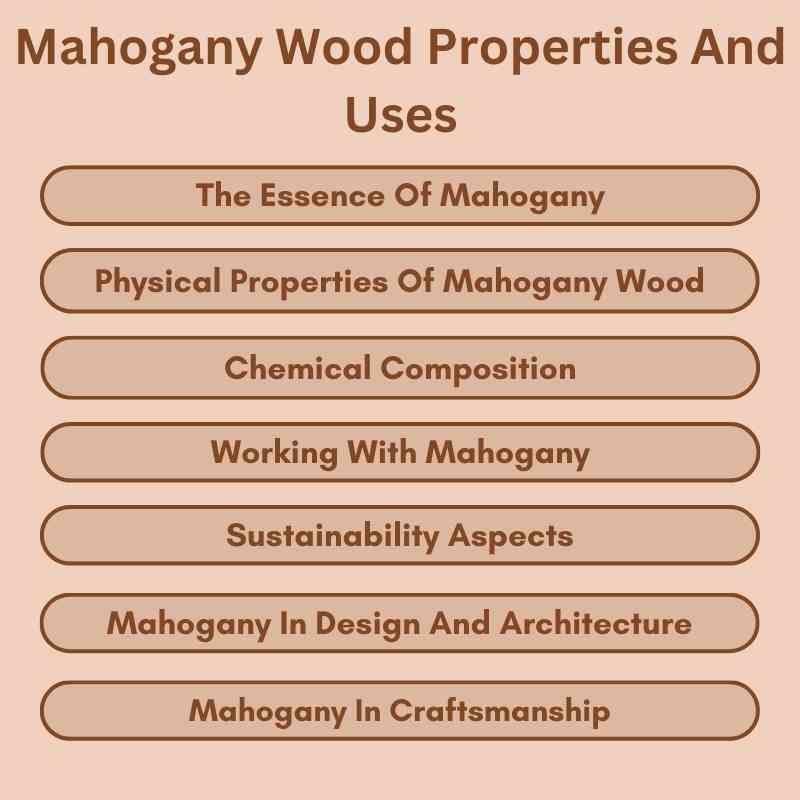Mahogany wood is prized for its durability, rich color, and resistance to decay. Common uses include furniture, cabinetry, and musical instruments.
Mahogany wood is a highly sought-after material known for its aesthetic appeal and robust properties. With its deep reddish-brown hue, it adds elegance to any space. This hardwood is renowned for its strength, making it ideal for crafting durable furniture and cabinetry.
Its natural resistance to moisture and insects enhances its longevity, making it a popular choice in both indoor and outdoor applications. Mahogany also boasts excellent workability, allowing for intricate designs and finishes. Whether used in traditional or modern settings, mahogany brings warmth and sophistication. Understanding its properties and uses can help you make informed decisions for your next woodworking project.
The Essence Of Mahogany
Mahogany wood is a symbol of beauty and strength. Its rich color and durability make it a top choice for furniture. Many people admire its unique grain patterns. Understanding its properties helps in making informed choices.
Origins And Distribution
Mahogany trees belong to the Swietenia genus. These trees are native to tropical regions. They primarily grow in:
- Central America
- South America
- The Caribbean
Some popular species include:
| Species | Location |
|---|---|
| Swietenia macrophylla | Central and South America |
| Swietenia mahagoni | Caribbean region |
Mahogany trees thrive in warm, humid climates. They can grow up to 150 feet tall. This height contributes to their impressive wood yield.
Botanical Characteristics
Mahogany wood has distinct features. Its color ranges from light pink to deep red-brown. The wood is known for:
- Fine, straight grain
- Medium to high density
- Natural resistance to decay
These characteristics make mahogany a favorite for various applications. It’s easy to work with and takes stains well. Craftsmen appreciate its:
- Workability
- Durability
- Aesthetic appeal
Mahogany also has a pleasant aroma. This adds to its allure in woodworking. Its properties ensure it remains a timeless choice.

Physical Properties Of Mahogany Wood
Mahogany wood is famous for its beautiful appearance and strength. It has unique physical properties that make it highly desirable for various uses. Understanding these properties helps in selecting the right wood for projects.
Color And Texture
Mahogany wood is known for its rich, warm colors. Here are some key points:
- Color: Ranges from reddish-brown to deep mahogany.
- Texture: Smooth and even, with a fine grain.
- Finish: Takes stain and polish very well.
This wood’s vibrant color adds elegance to furniture and decor.
Density And Hardness
Mahogany is a dense and hard wood. Its density affects its performance:
| Property | Value |
|---|---|
| Density | Approximately 600 kg/m³ |
| Hardness | Moderate to high on the Janka scale |
These factors make mahogany suitable for heavy-use items like tables and cabinets.
Durability Factors
Durability is a crucial factor for any wood. Mahogany offers:
- Resistance to decay: Great for outdoor projects.
- Insect resistance: Natural oils repel pests.
- Longevity: Lasts for decades with proper care.
These durability factors make mahogany a top choice for furniture and flooring.
Chemical Composition
The chemical composition of mahogany wood plays a crucial role in its properties. Understanding these elements helps in appreciating its strength, beauty, and durability. Mahogany is known for its rich color and fine grain, making it a favorite among woodworkers and furniture makers.
Natural Oils And Resins
Mahogany wood contains various natural oils and resins. These components contribute to its unique characteristics:
- Oil Content: Provides moisture resistance.
- Resin Composition: Enhances durability and longevity.
- Natural Fragrance: Gives a pleasant scent to the wood.
These natural elements make mahogany wood suitable for various applications. It is often used in high-quality furniture and cabinetry.
Impact On Durability And Scent
The chemical composition impacts both durability and scent. Here’s how:
| Property | Impact |
|---|---|
| Durability | Natural oils protect against moisture and decay. |
| Scent | Natural oils give a rich, warm aroma. |
Mahogany’s durability makes it ideal for both indoor and outdoor use. Its pleasant scent adds to its appeal in crafted items.
Working With Mahogany
Mahogany wood is a favorite among woodworkers. Its beauty and durability make it ideal for various projects. Understanding how to work with mahogany is crucial for achieving the best results.
Machining And Workability
Mahogany is known for its excellent workability. It cuts smoothly and sands easily. Here are some key points about machining mahogany:
- Hand Tools: Mahogany responds well to hand tools.
- Power Tools: It machines easily with power tools.
- Resistance: The wood resists chipping and splintering.
Take care when using sharp tools. Mahogany can produce fine dust. Always wear a mask to avoid inhaling dust particles.
Finishing And Polishing
Finishing mahogany enhances its natural beauty. It often has a rich color and grain pattern. Here’s how to effectively finish mahogany:
- Sanding: Start with medium-grit sandpaper, then progress to fine-grit.
- Staining: Use a wood stain for deeper color.
- Sealing: Apply a wood sealer to protect the surface.
- Polishing: Use a soft cloth for a high-gloss finish.
Mahogany absorbs finishes well. This leads to a smooth and appealing surface. Always test finishes on a scrap piece first.
Sustainability Aspects
Mahogany wood is prized for its beauty and durability. Its sustainability is crucial for the environment. Understanding conservation efforts and certified sources helps promote responsible use.
Conservation Efforts
Mahogany trees face threats from overharvesting and habitat loss. Various organizations work to protect these trees. Key efforts include:
- Reforestation: Planting new trees to replace those cut down.
- Education: Teaching communities about sustainable practices.
- Legal protection: Enforcing laws to prevent illegal logging.
These actions help maintain healthy ecosystems. They also ensure that future generations can enjoy mahogany.
Certified Sustainable Sources
Buying mahogany from certified sources supports sustainability. Look for certifications such as:
| Certification | Description |
|---|---|
| FSC | Ensures responsible forest management. |
| PEFC | Promotes sustainable forest practices. |
Certified wood comes from well-managed forests. This practice reduces the impact on the environment.
Choosing certified mahogany supports local communities. It also encourages sustainable forestry practices.
Mahogany In Design And Architecture
Mahogany wood is famous for its beauty and durability. It has been used in design and architecture for centuries. This wood adds warmth and elegance to any space. Its rich color and fine grain make it a popular choice among designers.
Historical Significance
Mahogany has a rich history in design and architecture. It was prized in the 18th and 19th centuries. Many famous furniture pieces were crafted from this wood. Its use was popular among the wealthy and elite. Key points include:
- First discovered in Central America.
- Used in ships and fine furniture.
- Symbol of luxury and status.
- Crafted into intricate carvings and designs.
| Era | Use of Mahogany |
|---|---|
| 18th Century | Furniture and Interior Design |
| 19th Century | Shipbuilding and Cabinetry |
| Modern Times | Architectural Features and Decor |
Modern Applications
Today, mahogany remains a favorite in modern design. Its versatility allows for various uses. Designers appreciate its aesthetic appeal. Common applications include:
- Furniture: Tables, chairs, and cabinets.
- Flooring: Durable and attractive hardwood floors.
- Cabinetry: Elegant kitchen and bathroom cabinets.
- Architectural Details: Moldings, trims, and doors.
Mahogany can enhance any space with its classic look. It blends well with many styles, from traditional to contemporary. Choosing mahogany adds a touch of luxury to design.
Mahogany In Craftsmanship
Mahogany wood is highly valued in craftsmanship. Its rich color and durability make it a favorite among artisans. Two main areas where mahogany shines are instrument making and fine furniture crafting.
Instrument Making
Mahogany is popular for making musical instruments. Its warm tone enhances sound quality. Here are some key benefits of using mahogany in instrument making:
- Sound Quality: Produces a rich, warm sound.
- Durability: Resists warping and cracking.
- Aesthetic Appeal: Beautiful grain patterns attract musicians.
Common instruments crafted from mahogany include:
- Guitars
- Pianos
- Drum shells
Musicians appreciate mahogany for its resonance and beauty.
Fine Furniture Crafting
Fine furniture crafted from mahogany is timeless. Its rich, deep hues offer elegance to any space. Here are some reasons why mahogany is a top choice:
- Stability: Holds its shape under different conditions.
- Workability: Easy to carve and shape.
- Longevity: Lasts for generations with proper care.
Popular furniture pieces made from mahogany include:
| Furniture Type | Description |
|---|---|
| Dining Tables | Sturdy and stylish, perfect for gatherings. |
| Cabinets | Elegant storage options with intricate designs. |
| Chairs | Comfortable and visually appealing seating. |
Mahogany furniture adds luxury to homes. Its classic charm never goes out of style.
Maintenance And Care
Mahogany wood is beautiful and durable. Proper maintenance keeps it looking great. Regular care ensures its longevity and performance.
Cleaning Practices
Cleaning Mahogany wood is simple. Use these easy steps:
- Use a soft, dry cloth for dusting.
- For deeper cleaning, dampen the cloth with water.
- Never use harsh chemicals or abrasive materials.
- Wipe in the direction of the grain.
For sticky spots, mix mild soap with water. Apply lightly, then dry immediately.
Longevity Tips
Follow these tips to prolong Mahogany wood life:
- Keep it away from direct sunlight.
- Maintain humidity levels between 40-60%.
- Use coasters under drinks to prevent water rings.
- Apply a furniture polish every 3-6 months.
Check for scratches or dents regularly. Repair them as soon as possible. A little care goes a long way.

Frequently Asked Questions
What Are The Key Properties Of Mahogany Wood?
Mahogany wood is known for its durability and resistance to decay. It has a rich, reddish-brown color and fine grain. This hardwood is easy to work with, making it ideal for furniture and cabinetry. It also has excellent acoustic properties, making it popular for musical instruments.
How Is Mahogany Wood Used In Furniture?
Mahogany wood is highly sought after for making high-quality furniture. Its strength and beautiful appearance add elegance to any piece. It is often used in cabinets, tables, and chairs. Mahogany’s resistance to warping ensures that furniture maintains its shape over time, making it a durable choice.
Is Mahogany Wood Eco-friendly?
Mahogany wood can be sustainable, depending on its source. Responsible harvesting practices are crucial to ensure the tree populations remain stable. Look for certified sustainable mahogany to minimize environmental impact. This ensures that you are making a responsible choice while enjoying the beauty of this wood.
How Does Mahogany Compare To Other Hardwoods?
Mahogany stands out for its color, grain, and workability. Compared to oak, it is softer and easier to shape. While maple is denser, mahogany offers a warmer tone. Its unique characteristics make it a preferred choice for fine woodworking and high-end projects.
Conclusion
Mahogany wood stands out for its rich color and durability. Its natural resistance to decay makes it perfect for furniture, cabinetry, and flooring. By choosing mahogany, you invest in beauty and longevity. Understanding its properties helps you appreciate its value in various applications.
Embrace this timeless wood in your next project.

